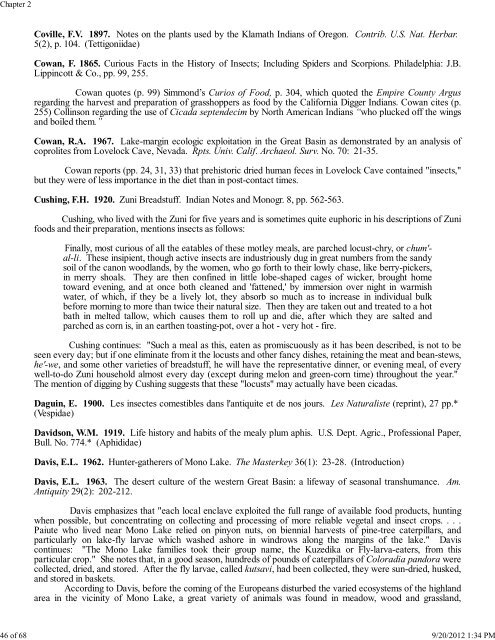Chapter 2. Insect Foods of North American Indigenous Populations ...
Chapter 2. Insect Foods of North American Indigenous Populations ...
Chapter 2. Insect Foods of North American Indigenous Populations ...
You also want an ePaper? Increase the reach of your titles
YUMPU automatically turns print PDFs into web optimized ePapers that Google loves.
<strong>Chapter</strong> 246 <strong>of</strong> 68 9/20/2012 1:34 PMCoville, F.V. 1897. Notes on the plants used by the Klamath Indians <strong>of</strong> Oregon. Contrib. U.S. Nat. Herbar.5(2), p. 104. (Tettigoniidae)Cowan, F. 1865. Curious Facts in the History <strong>of</strong> <strong>Insect</strong>s; Including Spiders and Scorpions. Philadelphia: J.B.Lippincott & Co., pp. 99, 255.Cowan quotes (p. 99) Simmond’s Curios <strong>of</strong> Food, p. 304, which quoted the Empire County Argusregarding the harvest and preparation <strong>of</strong> grasshoppers as food by the California Digger Indians. Cowan cites (p.255) Collinson regarding the use <strong>of</strong> Cicada septendecim by <strong>North</strong> <strong>American</strong> Indians “who plucked <strong>of</strong>f the wingsand boiled them.”Cowan, R.A. 1967. Lake-margin ecologic exploitation in the Great Basin as demonstrated by an analysis <strong>of</strong>coprolites from Lovelock Cave, Nevada. Rpts. Univ. Calif. Archaeol. Surv. No. 70: 21-35.Cowan reports (pp. 24, 31, 33) that prehistoric dried human feces in Lovelock Cave contained "insects,"but they were <strong>of</strong> less importance in the diet than in post-contact times.Cushing, F.H. 1920. Zuni Breadstuff. Indian Notes and Monogr. 8, pp. 562-563.Cushing, who lived with the Zuni for five years and is sometimes quite euphoric in his descriptions <strong>of</strong> Zunifoods and their preparation, mentions insects as follows:Finally, most curious <strong>of</strong> all the eatables <strong>of</strong> these motley meals, are parched locust-chry, or chum'-al-li. These insipient, though active insects are industriously dug in great numbers from the sandysoil <strong>of</strong> the canon woodlands, by the women, who go forth to their lowly chase, like berry-pickers,in merry shoals. They are then confined in little lobe-shaped cages <strong>of</strong> wicker, brought hometoward evening, and at once both cleaned and 'fattened,' by immersion over night in warmishwater, <strong>of</strong> which, if they be a lively lot, they absorb so much as to increase in individual bulkbefore morning to more than twice their natural size. Then they are taken out and treated to a hotbath in melted tallow, which causes them to roll up and die, after which they are salted andparched as corn is, in an earthen toasting-pot, over a hot - very hot - fire.Cushing continues: "Such a meal as this, eaten as promiscuously as it has been described, is not to beseen every day; but if one eliminate from it the locusts and other fancy dishes, retaining the meat and bean-stews,he'-we, and some other varieties <strong>of</strong> breadstuff, he will have the representative dinner, or evening meal, <strong>of</strong> everywell-to-do Zuni household almost every day (except during melon and green-corn time) throughout the year."The mention <strong>of</strong> digging by Cushing suggests that these "locusts" may actually have been cicadas.Daguin, E. 1900. Les insectes comestibles dans l'antiquite et de nos jours. Les Naturaliste (reprint), 27 pp.*(Vespidae)Davidson, W.M. 1919. Life history and habits <strong>of</strong> the mealy plum aphis. U.S. Dept. Agric., Pr<strong>of</strong>essional Paper,Bull. No. 774.* (Aphididae)Davis, E.L. 196<strong>2.</strong> Hunter-gatherers <strong>of</strong> Mono Lake. The Masterkey 36(1): 23-28. (Introduction)Davis, E.L. 1963. The desert culture <strong>of</strong> the western Great Basin: a lifeway <strong>of</strong> seasonal transhumance. Am.Antiquity 29(2): 202-21<strong>2.</strong>Davis emphasizes that "each local enclave exploited the full range <strong>of</strong> available food products, huntingwhen possible, but concentrating on collecting and processing <strong>of</strong> more reliable vegetal and insect crops. . . .Paiute who lived near Mono Lake relied on pinyon nuts, on biennial harvests <strong>of</strong> pine-tree caterpillars, andparticularly on lake-fly larvae which washed ashore in windrows along the margins <strong>of</strong> the lake." Daviscontinues: "The Mono Lake families took their group name, the Kuzedika or Fly-larva-eaters, from thisparticular crop." She notes that, in a good season, hundreds <strong>of</strong> pounds <strong>of</strong> caterpillars <strong>of</strong> Coloradia pandora werecollected, dried, and stored. After the fly larvae, called kutsavi, had been collected, they were sun-dried, husked,and stored in baskets.According to Davis, before the coming <strong>of</strong> the Europeans disturbed the varied ecosystems <strong>of</strong> the highlandarea in the vicinity <strong>of</strong> Mono Lake, a great variety <strong>of</strong> animals was found in meadow, wood and grassland,
















